To create custom tea blends, you'll need essential tools like a digital scale, airtight containers, and tea bags or filters. Choose high-quality, fresh tea leaves as your base, then add aromatic herbs, dried fruits, and edible flowers for unique flavors. Experiment with spices to enhance complexity, but use them sparingly. Properly store your ingredients in cool, dark places to maintain freshness. When blending, start with a 60-70% base tea and adjust complementary ingredients to taste. Measure carefully, aiming for 1-2 teaspoons per cup of water. Don't forget to label your creations with blend names and steeping instructions. The world of DIY tea blending offers endless possibilities for your perfect cup.
Essential Tools for Tea Blending
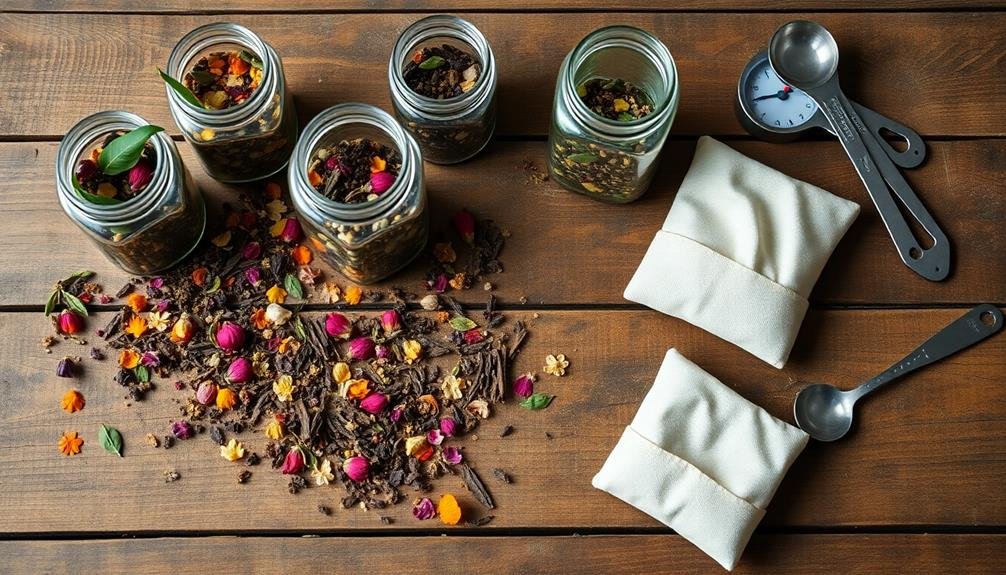
Everyone can create their own custom tea blends with just a few essential tools. To get started, you'll need a reliable digital scale to measure your ingredients accurately. Opt for a scale that can weigh in grams and has a precision of 0.1g for the best results.
Next, invest in airtight storage containers to keep your loose tea leaves and herbs fresh. Glass jars or metal tins work well, but make certain they're opaque to protect your ingredients from light exposure.
You'll also need a set of measuring spoons for smaller quantities and a large mixing bowl for combining ingredients.
Don't forget about tea bags or filters. You can use pre-made empty tea bags or invest in a tea bag sealer for a more professional look. A mortar and pestle can be useful for crushing larger herbs or spices.
Lastly, consider getting a tea journal to record your blend recipes and tasting notes. This will help you refine your creations over time.
With these tools at hand, you're ready to start experimenting with your own unique tea blends.
Selecting Quality Bulk Tea Leaves
With your tea blending tools ready, it's time to focus on the heart of your custom blends: the tea leaves themselves. When selecting bulk tea leaves, prioritize quality and freshness. Look for whole, intact leaves rather than broken pieces or dust. The aroma should be strong and characteristic of the tea type.
Consider the following tea varieties for your blends:
| Tea Type | Flavor Profile | Best For |
|---|---|---|
| Black | Bold, robust | Morning blends |
| Green | Grassy, invigorating | Light, rejuvenating mixes |
| Oolong | Complex, floral | Sophisticated blends |
Choose organic teas when possible to avoid pesticides and chemicals. Pay attention to the tea's origin, as different regions produce distinct flavors. For example, Chinese green teas differ from Japanese varieties in taste and aroma.
Store your bulk tea leaves in airtight containers away from light, heat, and moisture. This will preserve their freshness and flavor. When measuring for blends, use a digital scale for accuracy. Remember, a little goes a long way with high-quality leaves, so start with small quantities and adjust to taste.
Fragrant Herbs for Tea Blends

When creating your own tea blends, you'll want to explore fragrant herbs that can enhance the flavor and aroma of your brew.
Popular aromatic options include lavender, chamomile, mint, and lemon balm, which you can grow and dry yourself or purchase pre-dried.
As you experiment with herb combinations, you'll discover exciting flavor profiles that complement your chosen tea leaves and suit your personal taste preferences.
Popular Aromatic Tea Herbs
Aromatic herbs play an essential role in creating delightful tea blends. When crafting your own custom tea bags, you'll want to contemplate incorporating some of these popular fragrant herbs to enhance both flavor and aroma.
Lavender, chamomile, and mint are classic choices that offer distinct, recognizable scents. Lavender provides a floral, calming note, while chamomile imparts a sweet, apple-like fragrance. Mint varieties, such as peppermint and spearmint, add a revitalizing coolness to your blend.
For more exotic aromas, try lemongrass, which offers a citrusy scent, or rosemary, with its pine-like fragrance. Hibiscus contributes a tart, fruity aroma, and rose petals bring a romantic, floral touch to your tea.
Here's a quick reference guide for popular aromatic tea herbs:
| Herb | Aroma Profile | Flavor Notes |
|---|---|---|
| Lavender | Floral, calming | Sweet, perfumed |
| Chamomile | Sweet, apple-like | Mild, honey-like |
| Peppermint | Cool, invigorating | Strong, minty |
| Lemongrass | Citrusy, bright | Lemony, grassy |
When blending these herbs, remember that a little goes a long way. Start with small amounts and adjust to your taste preferences.
Drying Fresh Herbs
Freshly harvested herbs' vibrant flavors and aromas can be preserved for your DIY tea blends through proper drying techniques. Air drying is the simplest method, involving tying small bundles of herbs and hanging them in a warm, dry, and well-ventilated area. This process typically takes 1-2 weeks.
For faster results, you can use a food dehydrator or oven on its lowest setting, carefully monitoring the herbs to prevent over-drying.
When drying herbs for tea, it's essential to maintain their essential oils and flavors. Harvest herbs in the morning after the dew has evaporated but before the sun becomes too intense. Choose healthy, unblemished leaves and stems for the best quality dried herbs.
Once completely dry, store your herbs in airtight containers away from light and heat to maintain their potency.
Here are five tips to enhance your herb-drying experience:
- Use a drying screen for delicate herbs like mint or lemon balm
- Dry different herbs separately to prevent flavor mixing
- Check herbs daily for signs of mold or discoloration
- Crush dried herbs gently to release more flavor in your tea
- Experiment with drying flowers like chamomile or lavender for unique blends
Herb Flavor Combinations
With a world of fragrant herbs at your fingertips, creating unique and delicious tea blends becomes an exciting adventure. As you experiment with different combinations, you'll discover flavors that complement and enhance each other.
Start with classic pairings like peppermint and chamomile for a soothing blend, or lemongrass and ginger for a zesty, invigorating drink.
For a floral touch, try combining lavender with Earl Grey or rose petals with green tea. If you're looking for something more robust, mix cinnamon, clove, and cardamom for a warming chai-inspired blend.
Don't forget about fruity notes – dried apple pieces or orange peel can add a delightful sweetness to your concoctions.
When crafting your blends, aim for a balance of flavors. Combine stronger herbs like rosemary or thyme with milder ones such as lemon balm or chamomile.
Experiment with ratios to find the perfect harmony. Remember that some herbs, like mint and lemongrass, can easily overpower others, so use them sparingly.
As you gain confidence, try incorporating unexpected ingredients like holy basil or lemon verbena for unique flavor profiles. The possibilities are endless, so let your taste buds guide you in creating your perfect cup.
Dried Fruits for Flavor Enhancement
When creating your own tea blends, dried fruits can add a delightful burst of flavor and natural sweetness.
You'll find popular options like apple, strawberry, and citrus peels readily available for your experiments.
As you mix these fruits into your blends, you'll need to carefully balance their sweetness and acidity to achieve a harmonious taste profile.
Popular Dried Fruit Options
Dried fruits have long been a favorite addition to tea blends, offering a burst of natural sweetness and complexity. When creating your own tea blends, you'll find a wide variety of dried fruit options to choose from.
Popular choices include dried berries like strawberries, blueberries, and raspberries, which add a tart and sweet flavor profile. Citrus fruits such as lemon, orange, and grapefruit peel contribute a zesty, invigorating taste to your blend. For a tropical twist, consider using dried pineapple, mango, or papaya.
Don't overlook the classic additions of dried apple or pear, which provide a subtle sweetness and complement many tea bases. Dried stone fruits like peaches, apricots, and cherries can add depth and richness to your blend. When selecting dried fruits, opt for unsweetened varieties to maintain control over the sugar content in your tea.
Here are some tips for using dried fruits in your tea blends:
- Chop larger fruit pieces for even distribution
- Experiment with fruit combinations for unique flavors
- Start with small amounts and adjust to taste
- Store dried fruits in airtight containers to maintain freshness
- Consider rehydrating fruits before blending for a more intense flavor
Balancing Sweetness and Acidity
Achieving the perfect balance of sweetness and acidity in your DIY tea blends is essential for a well-rounded flavor profile. When incorporating dried fruits, you'll need to take into account their natural sugar content and tartness to create a harmonious taste.
Start by selecting a base tea, such as black, green, or herbal, and then add dried fruits strategically. For sweetness, opt for naturally sweet fruits like dried mangoes, figs, or dates. These will add depth and richness to your blend without overpowering the tea's natural flavors.
To introduce acidity, think about adding tart fruits like dried cranberries, currants, or citrus peels. These will provide a bright, zesty note that cuts through the sweetness and complements the tea's base.
Remember that a little goes a long way when balancing sweetness and acidity. Start with small amounts of dried fruits and adjust to taste. You can also experiment with combining sweet and tart fruits in different ratios to find your ideal blend.
Don't forget to reflect on how the fruits will interact with other ingredients like herbs or spices in your tea mix.
Flowers and Petals in Teas
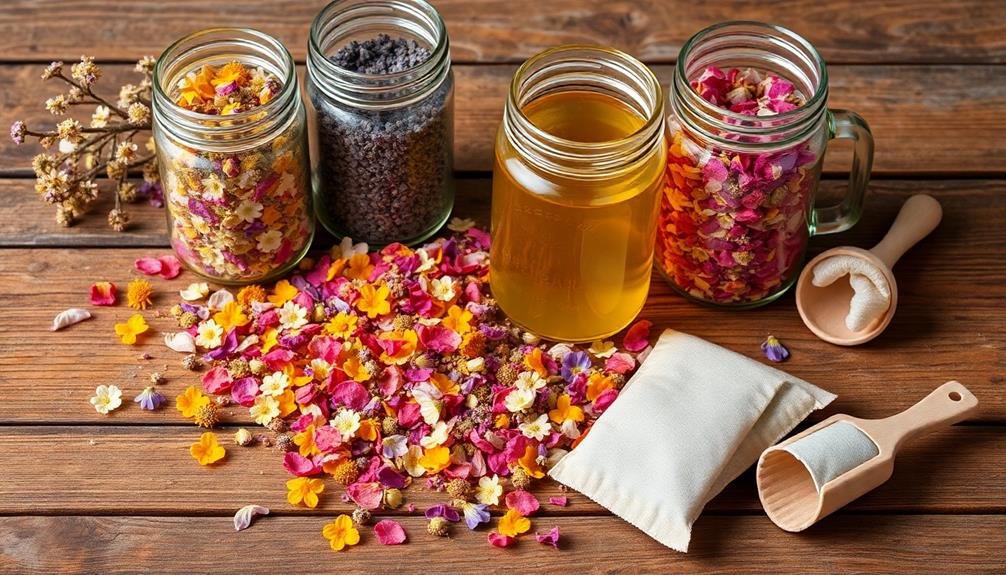
The beauty of floral teas lies in their delicate aromas and subtle flavors. When creating your own tea blends, contemplate incorporating flowers and petals to add a touch of elegance and complexity. You'll find that different flowers offer unique taste profiles, from the sweet and soothing chamomile to the bold and fragrant lavender.
When selecting floral ingredients for your tea, opt for organic, food-grade petals to guarantee safety and quality. Start with small amounts, as flowers can quickly overpower other flavors. Experiment with combinations like rose and black tea or jasmine and green tea to discover your perfect blend.
Don't forget to think about the visual appeal of your tea mixture, as colorful petals can create a stunning presentation.
Here are some popular flowers to use in your DIY tea blends:
- Chamomile: Calming and apple-like
- Lavender: Fragrant and slightly sweet
- Rose: Delicate and romantic
- Hibiscus: Tart and vibrant
- Chrysanthemum: Mild and slightly sweet
Remember to store your floral teas in airtight containers away from light and heat to preserve their flavors and aromas. With practice, you'll soon be crafting beautiful and delicious floral tea blends to enjoy and share.
Spices to Elevate Your Blends
Ready to take your tea blends to the next level? Spices can add depth, warmth, and complexity to your custom teas.
Start with cinnamon, a versatile spice that pairs well with black, green, and herbal teas. It's perfect for creating comforting blends or adding a touch of sweetness without sugar.
Ginger is another excellent choice, offering a spicy kick and potential digestive benefits. Try it with lemon or honey for a soothing blend.
For a more exotic flavor, consider cardamom. This aromatic spice complements both black and green teas, adding a unique, slightly sweet taste.
Cloves can bring a bold, warm flavor to your blends, but use them sparingly as they're quite strong. Nutmeg offers a subtle, nutty sweetness that works well in chai-inspired blends or with vanilla-based teas.
Don't forget about star anise, which imparts a distinct licorice flavor, or fennel seeds for a milder anise taste.
For a peppery kick, add a pinch of black peppercorns to your blend. Experiment with these spices individually or combine them to create your own signature tea blends.
Balancing Flavors in Custom Teas

Flavor harmony is key when creating custom tea blends. You'll want to strike a balance between the various ingredients to guarantee no single element overpowers the others.
Start with a base tea, such as black, green, or white, and build upon it with complementary flavors. Consider the strength of each ingredient and adjust quantities accordingly. Herbs and spices can add depth, while fruits and flowers contribute sweetness and aroma.
When balancing flavors, remember these tips:
- Use stronger flavors sparingly to avoid overwhelming the blend
- Pair complementary tastes, like citrus with floral notes or spices with earthy tones
- Experiment with different ratios to find the perfect balance
- Consider the brewing time and how it affects each ingredient's intensity
- Trust your palate and adjust as needed
Don't be afraid to try unexpected combinations, but always taste-test your blends before committing to large batches.
Keep notes on successful mixtures and those that need improvement. With practice, you'll develop an intuition for creating well-balanced, delicious custom tea blends that suit your unique taste preferences.
Proper Storage of Bulk Ingredients
Storing your bulk tea ingredients properly can make or break the quality of your custom blends. Keep your ingredients in airtight containers to prevent moisture and odors from affecting their flavor and aroma. Glass jars or food-grade plastic containers work well for this purpose. Store these containers in a cool, dark place away from direct sunlight, heat sources, and strong odors.
Different tea ingredients have varying shelf lives, so it's essential to label your containers with the purchase date and expected expiration. Here's a quick reference guide for common tea ingredients:
| Ingredient | Shelf Life | Storage Tips |
|---|---|---|
| Loose Leaf Tea | 1-2 years | Airtight container, dark place |
| Dried Herbs | 6-12 months | Airtight container, cool area |
| Dried Fruits | 6-12 months | Airtight container, refrigerate |
| Spices | 1-3 years | Airtight container, cool and dry |
| Flowers | 6-12 months | Airtight container, dark place |
Check your ingredients regularly for signs of spoilage, such as mold, discoloration, or off-odors. If you notice any of these signs, discard the affected ingredients immediately. By following these storage guidelines, you'll guarantee that your custom tea blends always taste fresh and delicious.
Measuring and Portioning Tea Ingredients

To create perfect tea blends, you'll need precision tools for accurate measurements.
A digital scale and measuring spoons are essential for consistent results. Aim for ideal ratios when blending, typically using 1-2 teaspoons of tea per cup of water as a starting point.
Precision Tools for Measurement
When it comes to crafting the perfect tea blend, precision is key. To achieve consistent results, you'll need the right tools for measuring your ingredients accurately. A digital scale with 0.1-gram precision is essential for weighing small quantities of tea leaves, herbs, and spices.
For larger amounts, a kitchen scale with a capacity of 1-5 kg will suffice. Measuring spoons are indispensable for portioning out smaller quantities, especially for powdered ingredients. Opt for a set that includes 1/8 teaspoon, 1/4 teaspoon, 1/2 teaspoon, and 1 teaspoon measurements.
For liquid additives, use graduated measuring cups with clear markings. To guarantee your blends are consistent, consider investing in a tea blending notebook to record your recipes and ratios. This will help you replicate successful blends and refine your creations over time.
Here are five precision tools you'll need for measuring tea ingredients:
- Digital scale (0.1-gram precision)
- Kitchen scale (1-5 kg capacity)
- Set of measuring spoons
- Graduated measuring cups
- Tea blending notebook
With these tools at your disposal, you'll be well-equipped to create perfectly balanced tea blends every time.
Ideal Ratios for Blending
Now that you have the right tools for precise measurements, let's explore the ideal ratios for blending tea ingredients.
When creating custom tea blends, it's essential to balance flavors and aromas for a harmonious result. Start with a base tea, typically comprising 60-70% of your blend. Black, green, or white teas work well as foundations.
For herbal blends, use equal parts of two to three main ingredients. Add complementary herbs or flowers at 10-20% of the total blend. Spices should be used sparingly, around 5-10%, as they can easily overpower other flavors. Dried fruits can make up 10-15% of your blend, adding sweetness and tang.
When experimenting with new combinations, start with small batches using a 3:2:1 ratio. This means three parts base tea, two parts secondary ingredient, and one part accent flavor. As you refine your blend, adjust these ratios to suit your taste preferences.
Remember that some ingredients are more potent than others. Strong flavors like peppermint or lemongrass should be used in smaller quantities than milder ingredients like chamomile or rose petals.
Always taste-test your blends and make notes for future reference.
Filling and Sealing Custom Tea Bags
Precision is key when filling and sealing your custom tea bags. You'll want to use the right amount of tea blend to guarantee peak flavor extraction. Generally, aim for 1 to 2 teaspoons of loose tea per bag, depending on the blend's density. Use a small funnel or spoon to carefully transfer your mix into empty tea bags or filters.
When sealing your tea bags, make sure they're tightly closed to prevent any loose leaves from escaping. If you're using heat-sealable bags, invest in a small impulse sealer for a professional finish. For paper filters, fold the top over and secure it with a staple or string. Remember to leave enough room for the tea to expand as it steeps.
Here are some tips to enhance your tea bag filling and sealing process:
- Use a digital scale for precise measurements
- Label your bags with blend names and steeping instructions
- Store filled bags in an airtight container to preserve freshness
- Consider adding a tag for easy removal from hot water
- Experiment with different bag materials to find your preference
With practice, you'll develop an efficient system for filling and sealing your custom tea bags, guaranteeing consistent quality and enjoyment with every cup.
Labeling and Packaging Your Creations
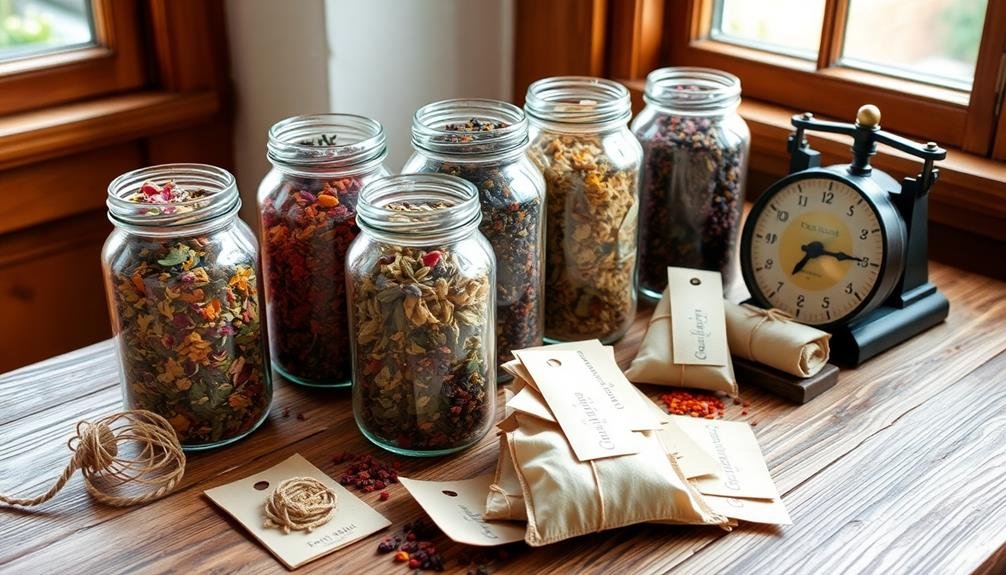
The final touch in creating your DIY tea blends is labeling and packaging them attractively. Start by designing clear, informative labels that include the blend name, ingredients, and steeping instructions. You can use a label maker, print custom labels, or even handwrite them for a personal touch. Don't forget to add the date of creation to guarantee freshness.
For packaging, consider using small tins, glass jars, or resealable kraft paper bags to keep your tea blends fresh. If you've made individual tea bags, you might want to package them in sets of 10 or 20 in decorative boxes or pouches.
Add a personal touch by including a brief description of the blend's flavor profile or the inspiration behind it. If you're giving your tea blends as gifts, think about creating a cohesive look with matching labels and packaging across different blends. You could also include a small card with brewing tips or suggested food pairings.
Remember to store your packaged teas in a cool, dry place away from direct sunlight to preserve their flavors and aromas. With careful labeling and attractive packaging, your DIY tea blends will look as good as they taste.
Frequently Asked Questions
Are There Any Tea Blends to Avoid for Health Reasons?
You should avoid tea blends containing comfrey, ephedra, or kava kava, as they can cause liver damage. Be cautious with detox teas, which may have laxative effects. Always research ingredients and consult a doctor if you're on medication.
Can I Use Fresh Ingredients Instead of Dried Ones in Tea Blends?
You can use fresh ingredients in tea blends, but they won't last as long. They'll spoil quickly and may not release flavors as effectively as dried ones. It's best to stick with dried ingredients for longer shelf life and better infusion.
How Long Do Homemade Tea Blends Typically Stay Fresh?
Your homemade tea blends can stay fresh for 6-12 months if stored properly. Keep them in airtight containers away from light, heat, and moisture. You'll notice a decline in flavor and aroma when they're past their prime.
Are There Any Ingredients That Don't Mix Well in Tea Blends?
You'll want to avoid mixing strong flavors that clash. Don't combine bitter herbs with sweet fruits, or strong mints with delicate florals. Also, be cautious with ingredients that have different steeping times, as they won't blend well.
Can I Create Caffeine-Free Versions of Popular Tea Blends?
Yes, you can create caffeine-free versions of popular tea blends. You'll need to replace caffeinated teas with herbal alternatives. Try using rooibos, chamomile, or fruit tisanes as your base. Experiment with similar flavors to mimic the original blend.
In Summary
You've now got all the tools and knowledge to create your own custom tea blends. Remember to experiment with different combinations of leaves, herbs, fruits, and flowers. Don't forget to store your ingredients properly and measure them carefully. As you fill and seal your tea bags, you're crafting unique flavors that reflect your taste. Label your creations with care, and you'll soon be sipping your very own signature blends. Enjoy the process and savor the results!


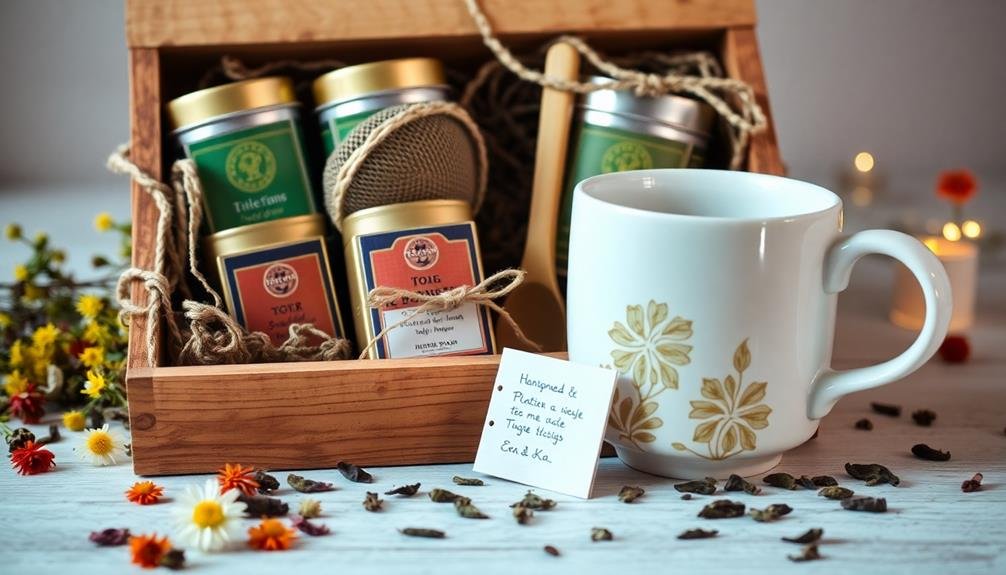
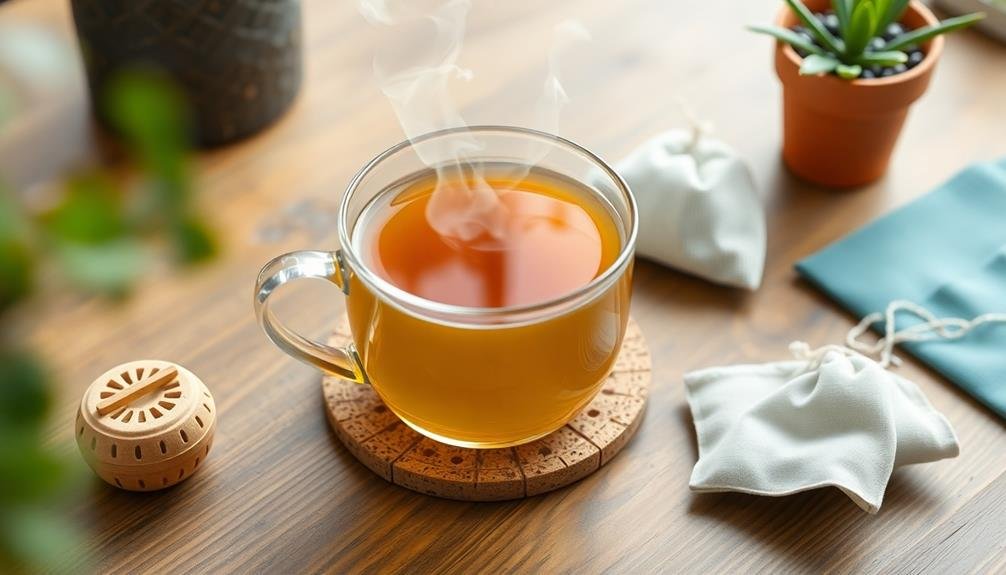
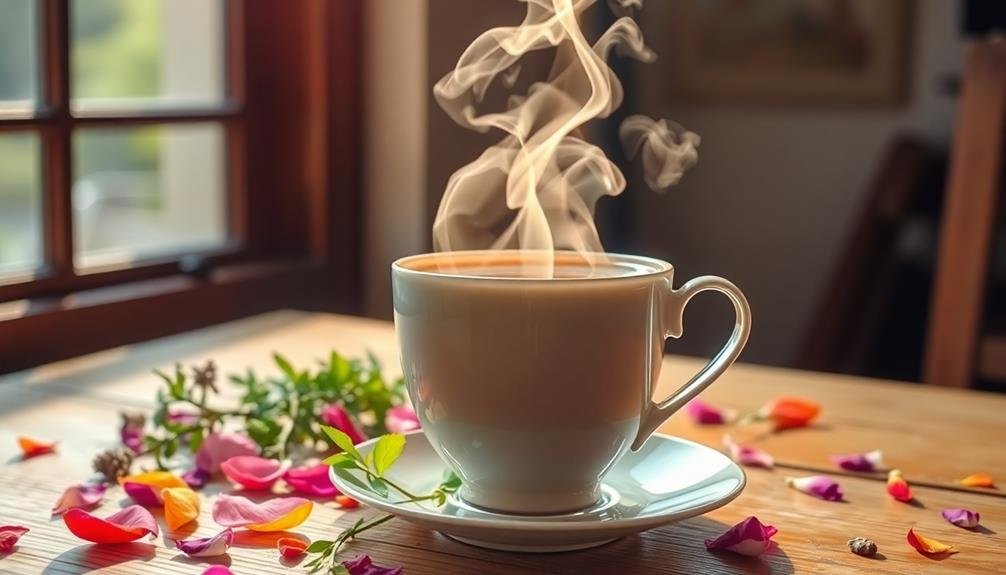
Leave a Reply